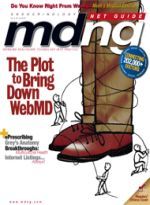Putting Patients at the Center of Care
Designing a New Toll for Chronic Paint Management
When “Mary Smith,” suffering from osteoarthritis, meets with her primary care physician, she’ll have in her hand a PDA device that holds a complete record of her chronic pain management regimen, including instructions for the exercises her physical therapist prescribed and the treatment notes from her chiropractor visit last month. She may even use the device to watch a video on how to perform the exercises when at home.
In the not-too-distant future, patients who suff er from chronic pain may be able to use a handheld computer to easily access and manage all their personal health activities and information, from reminders of medication schedules and guidance for exercise regimens, to tracking and monitoring how diff erent therapies aff ect their psychological well-being.
That’s the vision driving a new project being undertaken jointly by the University of Massachusetts Medical School (UMMS) and Aptima, Inc. (www.aptima.com), a company specializing in human-centered engineering, with the help of a grant from the Robert Wood Johnson Foundation program “HealthDesign: Rethinking the Power and Potential of Personal Health Records” (www.projecthealthdesign.org; www.aptima. com/news.php?id=3).
Managing Chronic Pain in Three Ways
The UMMS-Aptima team envisions the system helping patients to manage their chronic pain in three ways:
Information Exchange
The PDA will provide secure exchange of and access to patient health data for patients and all types of providers, whether or not they have an electronic health record.
Patient Reporting Patients will be able to easily record pain-related symptoms, the effect of pain on physical activity, and adherence to prescribed treatments. Patients will be able to update their status in pain and activity levels after a treatment or exercise, or in relation to a new medication, giving physicians a better picture than can be obtained from infrequent visits, when patient memory may be fuzzy.
Patient Learning
Patients will have access to health information tools and be able to download resources from the Internet, such as details on new medications and exercise programs. For patients without regular access to computers and Internet, the PDA will provide a portable source of information to use in their daily routine.
Putting Knowledge in Patients’ Hands
In addition to the technical challenge of collecting and presenting diverse medical and personal information, a key to the system’s success will be the ability of users of all ages and capabilities to easily handle the PDA device. This is especially challenging, given that the patients will be pain suff erers and will need a device that is exceptionally user-friendly.
To make that happen, Aptima will employ an approach known as “patient-centered” engineering, which will utilize the close involvement and feedback of chronic pain patients throughout the product development cycle. In this way, designers can systematically develop user-tested functionality while avoiding common design mistakes, such as building a product that’s too complicated for patients to use or that doesn’t integrate well into medical practitioners’ workflow.
Aptima designers believe the PDA device is the best hardware option for providing the functionality required in the project, because PDAs are a mature, widely available technology that can exchange information with existing electronic medical records systems, can connect wirelessly to the Internet, and can be used as stand-alone tools for sharing information with practitioners who may not have electronic records, such as acupuncturists and massage and physical therapists.
Building Toward a Prototype
Currently in the initial six-month phase of the project, the design team is working with chronic pain patients to determine how a PDA application could best assist them in the areas of medication management, physical therapy and exercise treatment management, and tracking and monitoring of behavioral therapies. One of these areas will be chosen for developing prototypes for further testing and development, a process that is expected to take about one year. And someday soon, the team believes, chronic pain sufferers will have a painless way to manage their treatment regimen.
Dr. Luckmann is a primary care internist and Associate Professor at UMass Medical School in the Department of Family Medicine and Community Health, where he serves as a clinician, educator, and informatics/health services researcher. He can be reached at luckmanr@ummhc.org.
Dr. Tyler is an expert in human experimental psychology and computer science, and the Principal Scientist for Human-System Integration at Aptima, Inc. He can be reached at styler@aptima.com.
